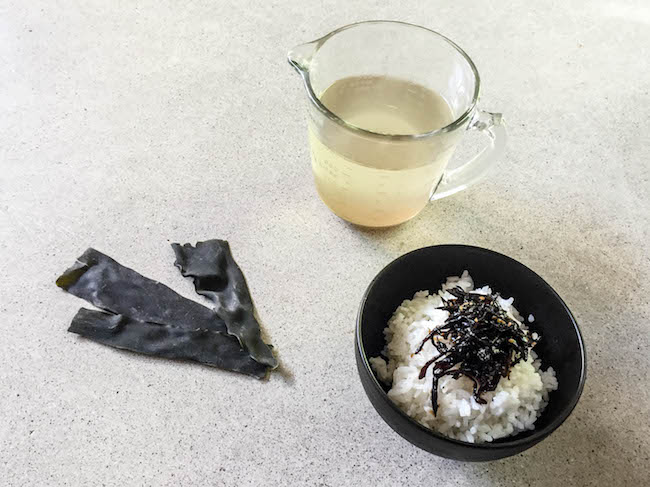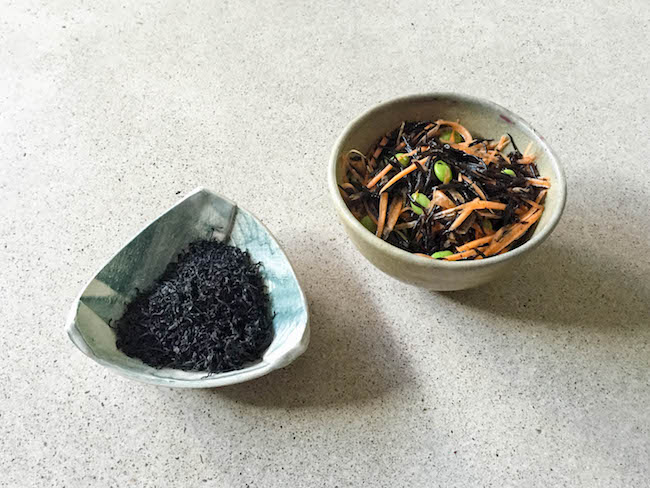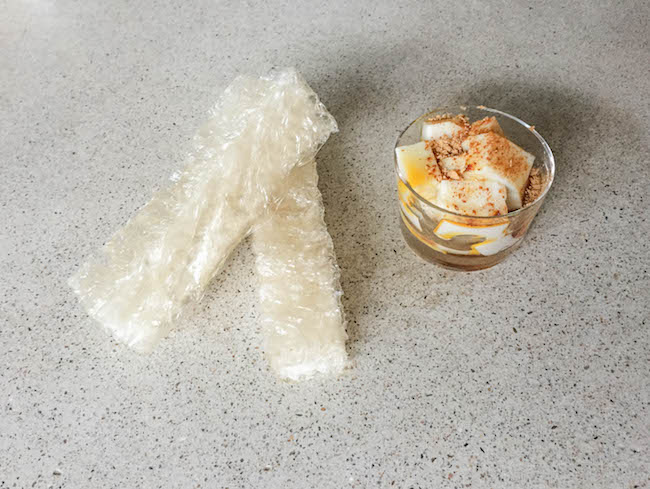Japanese Seaweed: A Guide to Japan’s Diverse Sea Vegetables
As an island nation, Japan harvests numerous types of seaweed from all around the country, such as hijiki from the crevices of rocks by the sea, and kombu from the shallow waters off the coastline. Seaweeds—and seaweed-derived products—have been central ingredients of Japanese cuisine for thousands of years. Healthy, low-calorie, packed with fiber, minerals and flavor, Japanese seaweeds are used in everything from preparing dashi broth, to salads, soups and wrapping sushi rolls. Here’s a guide to the seaweeds that are commonplace in both Japanese restaurants and homemade Japanese meals, so that you can enjoy these delicious and nutritious alternatives to land-based green vegetables.
What is Nori?

Nori, or dried laver, is perhaps the most familiar seaweed to people outside of Japan, as it is the variety used to make sushi rolls. Nori is almost always eaten dried, and is sold in sheets or strips for making sushi, wrapping onigiri (rice balls), and for eating plain as a snack. Dried nori sheets are produced by pressing shredded edible red algae into thin sheets and drying it, similar to the process of paper making. Other forms of nori include kizami nori (shredded nori), for garnishing dishes such as donburi (rice bowls), and aonori (powdered nori), used as a condiment on foods such as okonomiyaki and yakisoba. Flavored nori (ajitsuke) is also available, with common flavorings including soy sauce, salt, and sesame oil.
What is Kombu?

Kombu is a variety of bull kelp gathered mostly off the coast of Hokkaido in northern Japan. It has a tough, leathery texture that must be rehydrated before use. Packed with calcium and iron and a savory umami flavor, kombu is one of the main components of dashi broth, an essential ingredient in almost all Japanese dishes. In addition to being used for stock, kombu can be cooked in “tsukudani” style, where it is caramelised in soy sauce, sake, and sugar until the color darkens and the texture becomes soft and chewy. This type of kombu is a popular filling for onigiri, a topping on rice, and addition to salads and vegetables. Kombu can also be used to prepare a type of tea—kombu-cha—where dried kombu pieces are steeped in water.
What is Wakame?

Wakame is one of the most commonly consumed types of seaweed in Japan, and has a mild, sweet flavor. Fresh wakame is harvested from the Sea of Japan from February to June, but dried wakame is available year-round, and can be easily reconstituted by soaking in water or another liquid. Wakame is a common addition to salads, sunomono (vinegar-pickled vegetables), and miso soup. It can also be lightly stir-fried to make yaki-wakame.
What is Mekabu?

Mekabu is the flowering part of the same sea plant as wakame, found just above the root. It’s a briny, yet mildy sweet seaweed with a slimy texture that classifies it one of Japan’s “neba neba” foods. Mekabu is available either whole or shredded, dried or fresh. Try not to let the sliminess put you off—the briny flavor of mekabu is highly refreshing when paired with citrus-based ponzu dressing, or some vinegar and soy sauce. Enjoy mekabu in soups, salads, as a dipping condiment for noodles, or as a topping over rice.
What is Hijiki?

Hijiki is a type of seaweed collected from the rocky coastlines of Japan. It has a thin and knobby, somewhat branchlike appearance, and a nutty, earthy, slightly fishy flavor. It is commonly used stews and soupy dishes such as ochazuke, and in salads, where it is combined with ingredients such as fried tofu, julienned carrots, shelled edamame, konnyaku, lotus root, and and other vegetables, dressed with sweetened soy sauce, and mirin. Hijiki is purchased in dried form, and for use it in salads, hijiki is first rehydrated in water then drained.
What is Kanten (Agar Agar)?

Kanten, also called agar agar, is a gelifying agent extracted from seaweed. It’s typically used in Japanese cuisine for making puddings, custards and wagashi (traditional sweets) such as yokan and anmitsu. Kanten is an excellent plant-based alternative to gelatin derived from animal products, as it vegetarian and vegan-friendly. It can be bought in powdered, stick, thread and flaked form, and is dissolved in water then boiled before use. Kanten is more potent and results in a firmer jelly than animal-based gelatin, so if you’re using it as a gelatin substitute, the amount may need adjusting.
How to Buy Japanese Seaweed
Outside of Japan, the different varieties of Japanese seaweed can be found at Asian supermarkets, specialty grocers, health food stores, online retailers, and are also increasingly available in the international section of regular supermarkets. In general, darker-colored seaweeds indicates higher quality, while a bright green color can indicate that food coloring has been added.
Kombu is sold in thick, greenish-brown sheets with a leathery appearance. Wakame is typically sold in big bags of leafy dried seaweed that appear black when dried, but become green again when reconstituted with water. Mekabu may be difficult to buy outside of Japan, but can sometimes be found in health food stores and online retailers, most often in dried form, and can be either sold whole or shredded. Nori can be found almost anywhere—look for whole sheets for making sushi rolls, individually packaged strips for snacking, and shredded or powdered nori for decorating dishes. Hijiki is typically sold dried and packaged in bags, and has an appearance like black tea. Kanten is sold in stick, powder, and flake form, and all forms are equally as effective for producing jellied dishes.
If you’re interested in Japanese food or want to eat more healthily, then you should definitely try the wide variety of seaweeds available in Japanese cuisine. It’s easy to start with something familiar like nori, which you may have already eaten in sushi rolls, and then move on to wakame in miso soup, before trying the slimy-textured mekabu or unique-looking hijiki. Once you get a taste for Japanese seaweed, you won’t be able to stop. Itadakimasu!








